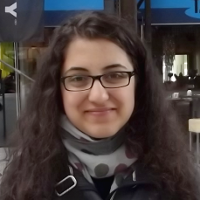
SENA KAYASÜ (ARCH/II)
sena.kayasu@ug.bilkent.edu.tr
This sentence, if you can mentally create the echo-like effect from the commercial, should be familiar to at least some of you. It’s the tagline for the 13th İstanbul Biennial; you can hear it on the radio or television. For someone who doesn’t even watch television, I’ve heard it too many times. So when I had the chance to go to İstanbul and see this international collection of contemporary art weekend before last, I took it. The Design and Architecture Society organized a compact day trip to cover the main points of the enormous exhibition. The dominant theme of this year’s Biennial was oppression and ostracizing. At first glance, this may seem irrelevant to the title and tagline presented this year. However, it makes sense once you know the story behind it.
The word “barbarian” comes from the Greek “barbaros,” which means “strange, foreign or ignorant.” Unlike that of most words, the origin of this one can be theorized: the apparently unintelligible “bar-bar” sound that a foreign language may be heard as by someone who does not speak it. In ancient Greece, this word came to mean “foreigner.” As in many other societies, this automatically gave the impression that the newcomer was inferior to the average Greek. So the foreigner came to be automatically ostracized, having been labeled as “barbarian” or “other.”
Works of art often talk about the oppressed or the jilted; art is a form of expression that prides itself in being able to transmit a message to the world to right the wrongs done by society. This is especially true for the arts that have a visual aspect but are able to transcend purely aesthetic expectations. What is tricky in doing this, though, is to not be a pessimist, as most of us so often tend to be in so many aspects of our lives. To quote one of my favorite movies, “The artist’s job is not to succumb to despair but to find an antidote for the emptiness of existence” (“Midnight in Paris,” by Woody Allen). Without being given hope, the viewer of an installation may feel that our society is going down a plughole and no one can do anything about it. Or worse, someone can, and won’t.
In my opinion, this is the true definition of art. To give people a purpose, to inspire and motivate them to do more, and better, is what the artist does. What we may not realize is that anyone can do this. You or I may not be prodigies in painting or sculpting, but we can speak, or write, or design structures, or invent a new technology, and this might, just might, change something for someone. Then, we become artists, even if no one knows our names. Then, we have impacted the world, and we rise above ourselves.
Isn’t that the point of being alive, anyway? Of being young, or young-spirited? All our lives, we try to get beyond ourselves, our knowledge, our experiences. We try to get beyond the scientific truth that humans, as another species in the kingdom Animalia, are only here for the biological purpose of maintaining the life cycle. To quote Nietzsche, “We have art in order not to die of the truth.” The irony here is, of course, that we always say we are searching for a Truth, Our Truth. We make it personal, to define truth in our own terms. When you think of it, we try to make everything personal. Last time I talked about everyone being the center of their own universe. I talked about the reasons for this, but a consequence is that we try to understand everything in our own terms. This is because the most reliable source of information, what with truth or reality apparently being varying concepts that dance into and out of our lives and our minds, is ourselves. Funny, because our own perceptions may not be viable at all; they may apply only to us. This brings up the question of how we decide what truth is.
There was one piece in the Biennial that may be able to shed some light on the subject. This was a video that outlined “13 Essential Rules For Understanding the World.” Being a work of art, it of course had to cast a deep, dark shadow first. One rule was “Never assume that you understand something, or pretend to. We all know you don’t understand anything, just like the rest of us.” Of course, this cannot be taken very literally, especially since another rule was, “Never try to prove an idea. No one will ever care.” However, maybe there is some sense in the assumption that truth is relative. Maybe Bilkent’s scientists reading this right now are thinking, “What on Earth does she think gravity is….” I think we’re capable of defining and redefining everything, whether it’s a city, or an idea, or the mood on a school trip. That’s the beauty of being the center of your own universe: not being able to reach a rigid, definitive truth means that you are not bound by it. You may not be able to change others, but you can change your own attitude, which may lead to places you never thought it would.
It may seem like I used a lot of writers’ quotes this week. Well, that’s true; but doesn’t that just go to show how much we are affected by what we see and hear? To complete a trio, here’s one from Oscar Wilde: “Life imitates art far more than art imitates life.” In this way, art is the answer to our continual search. Now I would like to go see the Anish Kapoor exhibition at the Sabancı Museum in İstanbul by January, and then my year will be complete.
